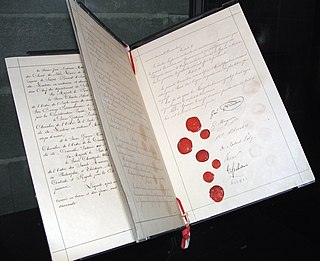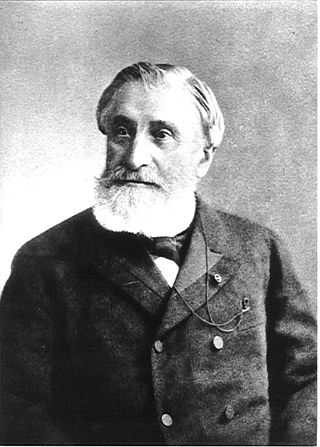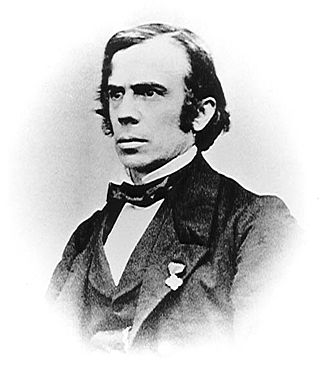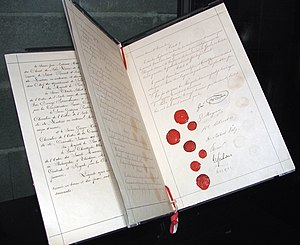
The organized International Red Cross and Red Crescent Movement is a humanitarian movement with approximately 16 million volunteers, members, and staff worldwide. It was founded to protect human life and health, to ensure respect for all human beings, and to prevent and alleviate human suffering. Within it there are three distinct organisations that are legally independent from each other, but are united within the movement through common basic principles, objectives, symbols, statutes, and governing organisations.

Henry Dunant, also known as Henri Dunant, was a Swiss humanitarian, businessman, social activist, and co-founder of the Red Cross. His humanitarian efforts won him the first Nobel Peace Prize in 1901.

The law of war is the component of international law that regulates the conditions for initiating war and the conduct of hostilities. Laws of war define sovereignty and nationhood, states and territories, occupation, and other critical terms of law.

The Second Geneva Convention for the Amelioration of the Condition of Wounded, Sick and Shipwrecked Members of Armed Forces at Sea is one of the four treaties of the Geneva Conventions. The Geneva Convention for the Amelioration of the Condition of Wounded, Sick and Shipwrecked Members of Armed Forces at Sea was first adopted in 1949, replacing the Hague Convention (X) of 1907. It adapts the main protective regime of the First Geneva Convention to combat at sea.
International humanitarian law (IHL), also referred to as the laws of armed conflict, is the law that regulates the conduct of war. It is a branch of international law that seeks to limit the effects of armed conflict by protecting persons who are not participating in hostilities and by restricting and regulating the means and methods of warfare available to combatants.

Gustave Moynier was a Swiss jurist who was active in many charitable organizations in Geneva.

Under the Geneva Conventions, the emblems of the International Red Cross and Red Crescent Movement are to be worn by all medical and humanitarian personnel and also displayed on their vehicles and buildings while they are in an active warzone, and all military forces operating in an active warzone must not attack entities displaying these emblems. The International Red Cross and Red Crescent Movement recognizes four protection emblems, three of which are in use: the Red Cross, the Red Crescent, the Red Lion and Sun, and the Red Crystal.

Louis Paul Amédée Appia was a Swiss surgeon with special merit in the area of military medicine. In 1863 he became a member of the Geneva "Committee of Five", which was the precursor to the International Committee of the Red Cross. Six years later he met Clara Barton, an encounter which had significant influence on Clara Barton's subsequent endeavours to found a Red Cross society in the United States and her campaign for an accession of the US to the Geneva Convention of 1864.

Dr. Théodore Maunoir was a Swiss surgeon and co-founder of the International Committee of the Red Cross (ICRC).

The International Committee of the Red Cross is a humanitarian organization based in Geneva, Switzerland, and is a three-time Nobel Prize laureate. The organization has played an instrumental role in the development of rules of war and promoting humanitarian norms.
The Rule of Law in Armed Conflicts Project is an initiative of the Geneva Academy of International Humanitarian Law and Human Rights to support the application and implementation of the international law of armed conflict.

The Geneva Conventions are international humanitarian laws consisting of four treaties and three additional protocols that establish international legal standards for humanitarian treatment in war. The singular term Geneva Convention colloquially denotes the agreements of 1949, negotiated in the aftermath of the Second World War (1939–1945), which updated the terms of the two 1929 treaties and added two new conventions. The Geneva Conventions extensively define the basic rights of wartime prisoners, civilians and military personnel; establish protections for the wounded and sick; and provide protections for the civilians in and around a war-zone.
The Geneva Convention for the Amelioration of the Condition of the Wounded and Sick in Armies in the Field, consisting of 39 articles in French, was adopted on 27 July 1929, at the end of the Diplomatic Conference of Geneva of 1929, which met from the 27 July until the 1 August of that year.

Jean Simon Pictet was a Swiss citizen, jurist, legal practitioner working in international humanitarian law. First as a secretary-jurist, and then as a senior executive and Vice-President of the International Committee of the Red Cross (ICRC), Pictet was instrumental in drafting the 1949 Geneva Conventions for the protection of victims of war, their Commentaries, and negotiating the 1977 Additional Protocols. He also proposed the Red Cross Movement’s seven Fundamental Principles, which were adopted at Vienna in 1965: Humanity, Impartiality, Neutrality, Independence, Voluntary Service, Unity and Universality. In 1989, an international humanitarian law competition for students was founded and named after him.

The Netherlands Red Cross was founded in 1867. It is among the Red Cross and Red Crescent Societies. It adopts branch governance structure which leads to approximately 214 branches that enables it to serve the whole country.

A Memory of Solferino is a book of the Swiss humanitarian Henry Dunant published in 1862. It proved decisive in the founding of the International Committee of the Red Cross.

Johan Hendrik Christiaan Basting was a Dutch army surgeon and friend of Red Cross founder Henri Dunant. He played an important role during the establishment in 1863 of the International Committee of the Red Cross (ICRC), and from that year on he was an advocate for the establishment of a national voluntary aid organization in the Netherlands, the Netherlands Red Cross established in 1867.

The archives of the International Committee of the Red Cross (ICRC) are based in Geneva and were founded in 1863 at the time of the ICRC's inception. It has the dual function to manage both current records and historical archives. The general historical archives are openly accessible to the general public up to 1975.

The library of the International Committee of the Red Cross (ICRC) – in French: la bibliothèque du Comité international de la Croix-Rouge (CICR) – is a public library based at the headquarter of the international organization in Geneva, Switzerland. It was apparently founded around the time of the ICRC's inception in 1863.

















